The Old Church And The New
During the years of the Wiley Heights Covenant Church, the question has often arisen how so many people from different Covenant Churches happened to settle in Wiley Heights. The name was derived from Wiley City, a small community in the vicinity. The story behind this provides an interesting account.
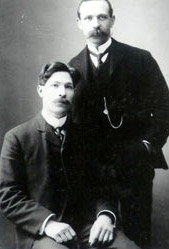
Two young men, Fridolf Nelson and Fingal Gothberg, both of them members of the Tabernacle Covenant Church in Chicago, were attracted to the “Gold Rush” in Nome, Alaska. Here they prospected for some time, then left for Seattle. There they heard of the land boom in Yakima, and of the Tieton Reclamation Project just being completed. Together with a third Alaska friend a Mr. Stevenson, they founded the Jupiter Investment Company, and bought land in Wiley Heights, suitable for orchards, now that irrigation water was becoming available.
By advertising this land in the “Mission Friend”, a paper well known in Covenant churches, it soon became known in Covenant churches in Omaha, St. Paul, and other places, and members of these churches moved West, and as a result, a Covenant church was formed.
We picture this district, before the first settlers arrived, as a land covered with sagebrush, rocks and dust. We have often heard the missionary, Martha Wiley, tell how she as a young girl would ride over these hills on her pony, enjoying the wide open spaces, and listening to the howling of the coyotes. She is a daughter of the late Hugh Wiley, founder of Wiley City, and before her retirement, spent forty-seven years as a missionary in China, sent out by the Congregational Church.
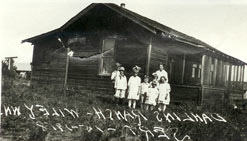
The August Dahlin family from St. Paul, started a Sunday School in their home in 1911, with an enrollment of ten members. The grandchildren of some of these members now belong to the Junior League in our church of today. Church services were also held in the homes in the community.
In February 1914, a Ladies Aid Society was organized in the Nathaniel Gothberg home, with a membership of twelve. This group is now known as the Covenant Women's Auxiliary.
In the early days the men would take the afternoon off from their ranch duties and attend the Ladies Aid meetings. And the women often found it convenient to have them along to drive the team, fix a broken harness, or guide an unruly horse over the rough roads. This society together with the Loyal Helpers, a group of younger women, had several auctions selling articles completed by the members. This money was used for missions, and for our church treasury, which often had a deficiency in past years.
Many times the Treasurer of the church would ask for a loan of a considerable sum, "when hard times came a’knocking at the door." These amounts were always loaned to the church, and later presented as a gift. It has often been said that the treasury in this organization was always full and running over.
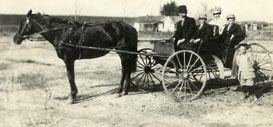
We look back through the years and smile at the "horse and buggy days." Then we look ahead and wonder if the youth of tomorrow, arriving in their private planes, will smile at the cars we are driving as of today.
On the 15th day of September 1915, the church was organized in the Dahlin home, with the Rev. David Swanson, pastor in the Selah Church, as chairman.
The charter members were:
Mr. & Mrs. Israel. Anderson, Mr. & Mrs. C August Dahlin, Mr. & Mrs. Fingal Gothberg, Mr. & Mrs. L.M. Nystrom, Mr. & Mrs. Nels Nystrom, Miss Ruth Elizabeth Nystrom.
As more families moved into the community, the need for a church building was felt, and in October 1916, it was decided to build. Mr. Nels Nystrom, then Treasurer, and an experienced builder, was appointed architect and supervisor for the project. Mr. Henry P. Carlson donated a centrally located lot out of his orchard, and the Jupiter Investment Company donated the stained glass windows.
Friends in the Omaha church donated $300, which was collected in Omaha, by the late Hulda Tissell-Hall. Gifts of money were also received from the St. Paul Covenant Church. Then with a loan of $300 from the North Pacific Conference, in which the church held membership, the work proceeded rapidly. Most of the men were carpenters, and all of the labor was donated.
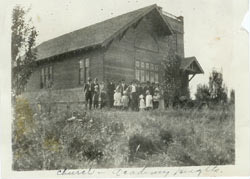
This beautiful little church, nestled in the apple orchards, was completed and finally dedicated, free from debt, on Sunday, July 25, 1920. Rev. August Skogsberg, from Minneapolis, gave the dedication address.
A bounteous dinner, prepared by the women, was served on the lawn of the Larson home, now the home of the Ed Worman family.
Two years later a Young People's Society was organized, thus completing the organizations of the church at that time.
A former missionary to China, Mr. Nathaniel Gothberg, a member of the church, served as pastor for twelve years; many years without remuneration. The last years he received $25.00 month.
Our first pastor, called by the church, was Rev. Milton Opsahl, an excellent Bible teacher, especially in the Old Testament. The first Sunday School Superintendent was Mr. Olof Lawrie, who still is active in the Wiley City Sunday School. The first janitor was Mr. Israel Anderson, and through all the years we have followed the custom of having the different members of the church acting as janitor for a week at a time.
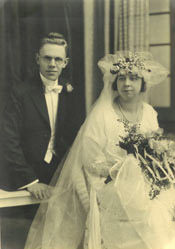
The first wedding held at the church was that of Arthur Tissell and Helen Clasen on December 7, 1921. The strains of Lohengrin’s Wedding March were heard from the little reed organ brought from Omaha by the Tissell family and donated to the church.
One Golden Wedding has been held in the church, that of Mr. and Mrs. Nels Nystrom on May 5, 1948.
At one time Rev. Alfred Hultman, known as the “Sunshine Singer” gave a concert. As there was no piano in the church, six stalwart Vikings carried a piano from the Torell home. Another evening Professor FrankErnest, Director of Music at North Park College, was to give a concert. Still – no piano! So a piano was taken to the church on an orchard slide, pulled by a team of horses, from the Clasen home, across the highway from Ed Worman's.
In 1923, at a monthly business meeting, a motion was made and carried that the Treasurer should buy a lantern, which was to hang outside of the church, by the steps.
For some years after Rev. Opsahl’s resignation, we were without a pastor, but through an agreement with the Selah Covenant Church, Rev. C.F. Pihlstrom favored us with a regular service on Sunday afternoons. Mr. R.S. Kelly, a Yakima businessman, was also often heard, and was well liked by everyone. Rev. C.R. Martin from Selah, Rev. Ralph Hetrick from Ahtanum, and Rev. Edward Arensen, also were interim pastors at different times.
Rev. Edward Arensen, a member of our church, together with his wife, Esther, have served as missionaries in Africa for fifteen years, under the auspices of the Africa Inland Mission. During their furloughs, they have spent a great deal of their time in Wiley Heights, and we have received a great many blessings, as they have told of the many experiences they have had during their ministry among the African people.
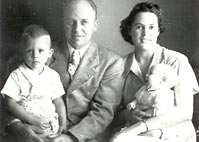
That a resident pastor was necessary for the future of the church was agreed upon, and in spite of the prevailing depression, it was decided in 1936 to build a parsonage. Since the Augustana Lutheran Church had discontinued its services in the community, the Covenant Church acquired title to its one acre property, and the parsonage was built on this land.
In 1937 Rev. Arvid Johnson accepted the call from the church, and was the first pastor to occupy the parsonage. Other pastors who have followed have been Rev. Irving Erickson, Rev. Carl Janson, Rev. Raymond L. Johnson, Rev. Alfred Johnson, and our present pastor, Rev. Vernon Anderson. We have seen many souls come to a saving knowledge of Jesus Christ through the preaching and teaching ministry of all of these men of God.
For a number of years Sunday School was held in the Cottonwood district, also a morning service, and cottage prayer meetings during the week. Sunday School was also held in Tampico. But when many of the families moved away during the war, and when the old Cottonwood School building was torn down, it was decided to bring the remaining members of both the Cottonwood and Tampico schools by bus to the Wiley Heights Church.
Through the years as attendance increased, the church was remodeled a number of times. The church was raised and the basement finished providing a fellowship hall, which was also used for Sunday School rooms, and a kitchen. At this time the cement platform outside of the church needed replacement. The following materials wore donated:
1 sack of cement by Gotfred Gothberg
1 sack of cement by C. P. Larson
½ sack of cement and gravel by Israel Anderson.
Hauling of material by A. V. Anderson.
Cost --- nothing.
Later the fireplace room on the east side was added. This addition provided a number of rooms for Sunday School classes, a pastor's study, and a. gathering place for the youth groups. In 1950 a Baldwin Electronic organ was installed.
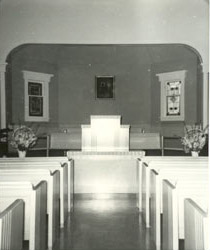
In 1951 the church applied for full membership in the Evangelical Covenant Church of America and was accepted. In 1955 the sanctuary was renovated (pictured at the right). Pews, a Communion table, pulpit, hymnals, and chimes were given as memorials. But all through the years we had been looking forward to the building of a new church; one that will not only be large enough for our own immediate vicinity, but one where we can better serve the spiritual needs of the entire community. Now with God's help this has become a reality. Once again we have made the "desert blossom like a rose", and as we dedicate this church building today, our prayer is that we may continue to do the work of the Lord in this our new church as we have done in the past. For it is not where we are, but what we are that makes us true servants of God.
By Ann Torell -1965
